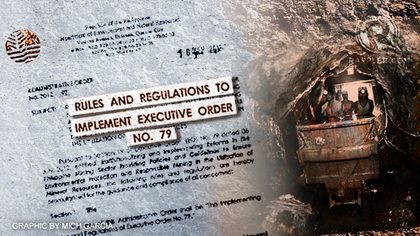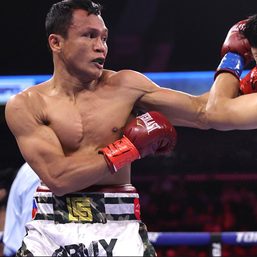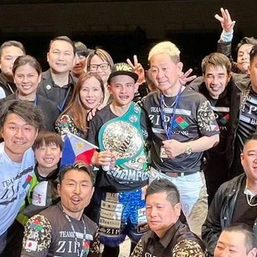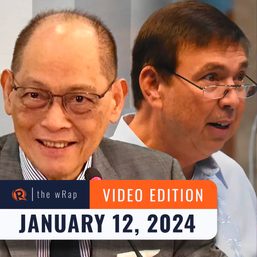SUMMARY
This is AI generated summarization, which may have errors. For context, always refer to the full article.

MANILA, Philippines – President Benigno Aquino III has approved the final version of the mining rules, which retained the cut in mining contracts’ maximum term from the current 50 years to 25 — a provision the industry had described as “patently illegal.”
In a briefing with reporters on Thursday, October 4, Presidential Communications Secretary Ricky Carandang said the implementing rules and regulations (IRR) of the government’s policy on mining under Executive Order 79 (EO-79) is “final.”
“We don’t anticipate anymore revisions. The President approved the changes,” Carandang said when asked about the call of big mining firms for a dialogue to thresh out the revisions to the IRR.
“I believe these clarifications in the IRR will resolve the issues raised by certain industry groups. Not exactly what they want but at least they provide clarity,” he added.
The IRR revisions were first announced on September 24, after industry players questioned the legality of some provisions of the original set of IRR, which in turn was published on September 14 and suspended on September 28.
The IRR has 4 most contentious provisions: the term of the mining contract; the no-go areas or those barred from any mining activities; the primacy of national over local laws, and; a no-new-contract policy put in place while the government and the mining firms pursue a revenue-sharing scheme in Congress.
Mining contract term
Carandang said the final version Aquino signed on October 4 would still have no automatic renewal of mining permits after 25 years of operation.
Mining companies have contested Section 9 of the revised IRR which, they said, violated the constitutional provision protecting the sanctity of contracts.
Section 9 imposes a bidding scheme in the renewal of mining contracts after the first 25 years of a tenement, effectively shortening the maximum 50-year period for projects.
It further states that, in the case of expiring 25-year mining tenements, “the mining contract/agreement that may be renewed shall be subject to new terms and conditions pursuant to the laws, rules and regulations that are existing at the time of the renewal.”
Industry leaders have said that, among the contentious provisions, Section 9 was the one that “pushed them to the wall” since this immediately has an impact on their cashflow and the value of their mining assets.
They said their creditors and other financiers based their loan terms on the maximum 50-year contract the firms sealed with the government.
Currently, the Mining Act provides for an initial 25-year contract, which is extended by another 25 years 6 months before the original contract ends. The terms of both contracts are similar, industry practitioners say, thus their contracts effectively have a 50-year term.
No new contracts
Meantime, Section 7 of the revised IRR tackles the no-new-contract scheme.
Earlier, the cement industry players said they would suffer becoming the “collateral damage” of this moratorium in the grant of new mining contracts since they regularly need permits to access indigenous raw materials for their manufacturing process.
Cement firms said these provisions could threaten their ability to make the investments they need to ensure future cement supply.
In the IRR version that President Aquino approved, Carandang said Section 7 now allows the expansion of mining and cement areas because preventing this might have economic repercussions on the companies.
Carandang said the IRR helps avoid “economic dislocation” of companies.
No-go areas
Other contentious provisions were about the “no-go” areas or locations that would be barred for any mining activity.
Miners feared that their areas of operations or those currently being explored could be identified as among the potential tourism or agricultural areas that could put their investments down the drain.
Earlier, Environment Secretary Ramon Paje explained that the no-go areas would cover those that are environmentally fragile and could be used for tourism activities.
Carandang said the President met with the Mining Industry Coordinating Council in the afternoon of October 3 in Malacañang to finalize the IRR. The council is composed of Paje, Finance Secretary Cesar Purisima, Energy Secretary Jose Rene Almendras, Presidential Assistant for Climate Change Secretary Elisea Gozon, Solicitor General Francis Jardeleza and Executive Secretary Paquito Ochoa Jr. – Rappler.com
Read the Blog on the 2012 Mining Conference for a blow-by-blow account of issues being discussed.
For the existing mining contracts in the Philippines, view this #WhyMining map.
How does mining affect you? Are you pro or against mining? Engage, discuss & take a stand! Visit Rappler’s #WhyMining microsite for the latest stories on issues affecting the mining sector. Join the conversation by emailing whymining@rappler.com your views on the issue.
For other views on mining, read:
| Yes to Mining | No to Mining |
More on #WhyMining:
- Shaping the future of mining
- EO: No new mining contracts
- The Mining EO: A mixed bag
- Mining E.O. not perfect, but very good
- CONVERSATIONS: What are your thoughts on the mining EO? #WhyMining
- Mining E.O. pits gov’t vs local execs
- Correcting lies and disinformation
- Stand for the environment
- How can mining work for Philippines?
- Mining is a social justice issue
- REPLAY: #WHYMINING
Add a comment
How does this make you feel?















There are no comments yet. Add your comment to start the conversation.